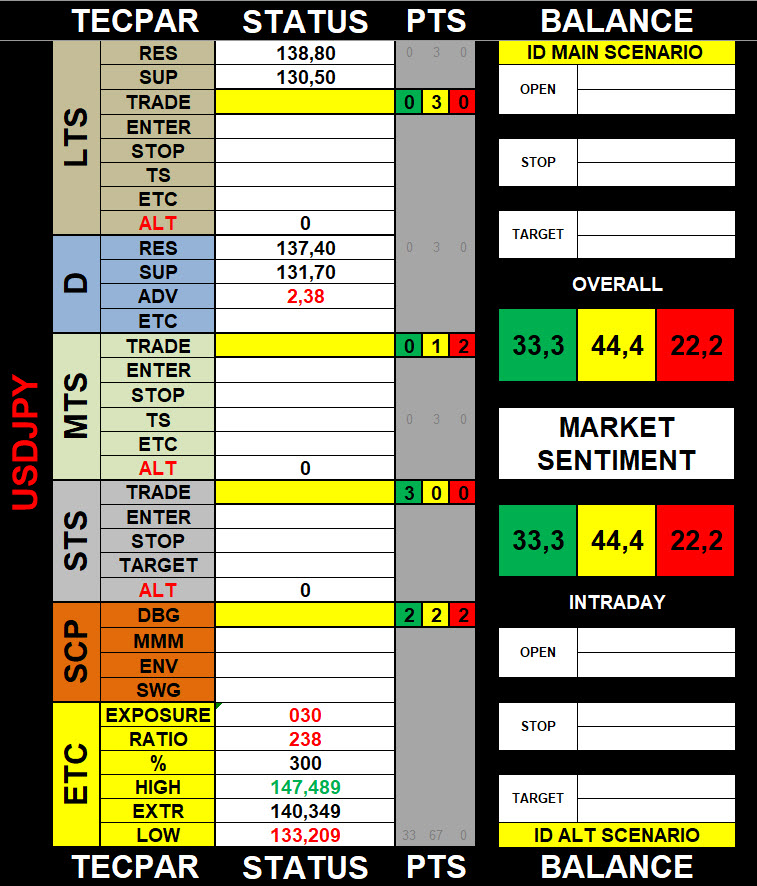Technical Profile of the Instrument
The Technical Profile or the Technical Passport of the financial instrument is quite a handy and useful analytical tool for any trader. No matter what style of trading you prefer, be it short-term, medium-term or long-term – if you see the full picture of price dynamics in the financial instrument on different timeframes, then you can more effectively manage your open position or portfolio, consisting of several positions, apply positions hedging techniques, in a timely manner increase or reduce your presence in the market. The Technical Profile of the financial instrument is the tool that allows you to do all of the above.
First of all, the Technical Profile of the instrument shows the current status of all formal and actual positions established in accordance with the rules of the trading strategies from which the portfolio of the trader consists of. Also, all key weekly and daily support and resistance levels, the current level of average daily volatility (ADV) in the instrument, the size of the spread and some other technical information are specified here as well. It is obvious, that the Technical Profile of the instrument reflects all the most important and useful information related to the financial instrument in terms of technical analysis.
In the diagram below you can see the Technical Profile of one of the financial instruments – the currency pair USDJPY.

The Technical Profile of any financial instrument is divided into several sections, that reflect the technical picture in the instrument from the perspective of the selected trading strategy. As you can see, there are LTS, MTS and STS sectors, corresponding to the long-term, medium-term and short-term trading strategies. There is also the sector D, which corresponds to daily timeframe, the sector SCP, which corresponds to scalping strategy and the sector ETC, which indicates other technical parameters of the financial instrument.
In the appropriate cells of the STATUS column are indicated the parameters of the current position in the financial instrument within the selected trading strategy. Here you can see the direction of the position (Red color – SHORT Position / Green color – LONG Position / Yellow color – No Positions), Position Entry Level (ENTER), Initial Stop Loss Level (STOP), as well as Current Trailing Stop Level (TS).
In the appropriate cells of the BAL (Balance) column is indicated the balance of power of market participants within the selected trading strategy on a three-point scale basis (Bulls – in green, Bears – in red and Neutrals in – yellow color). Moreover, it should be noted, that the number of points corresponds to the level of bullish, bearish or neutral sentiment towards the base currency or asset.
Finally, summing up the scores within all trading strategies, the overall balance of power in the selected instrument can be calculated as a percentage. This information is indicated in the rightmost column of the Technical Profile of the financial instrument (SENTIMENT).
No doubt, you might have a question, how to use all of this information in real trading and what it gives to a trader?
Talking about the practical value of the Technical Profile of the financial instrument, the most important point, that I would like to mention, is as follows – when trading on different timeframes according to the rules of different trading strategies, it is useful to see what is happening on a larger and a smaller timeframes of the selected financial instrument. If there is a confluence of signals generated by different trading strategies on different timeframes, then the probability of movement in the direction indicated by the signal in the selected timeframe increases.
For me, it’s quite obvious, that this information can be used as a trend indicator for those traders who like intraday trading. If you know the current level of ADV (average daily volatility) and the balance of power of market participants within the selected instrument, then this piece of information gives you an opportunity to evaluate the possibility of different trading scenarios during the trading day. Because of this reason, the Technical Profile of the instrument provides you with space for indicating the main and alternative scenarios for the upcoming trading day in the far right column. At last, the snapshot of the Technical Profile of the financial instrument taken before and after your trade can be a key element of your trading log.
GMT Partner offers its customers a subscription plan to the Technical Profile of a number of financial instruments. This service is a “must” for active traders and investors. To subscribe to the Technical Profile of the financial instruments that you trade, please send your request here or make your order here.
DISCLAIMER:
The risk of loss in trading Forex, futures, stocks and options can be substantial and is not suitable for all investors. Past performance is not necessarily indicative of future results. GMT Partner Ltd only provides educational services. By accessing any GMT Partner Ltd content, you agree to be bound by the terms of service. Testimonials are believed to be true based on the representations of the persons providing the testimonials, but facts stated in testimonials have not been independently audited or verified. Nor has there been any attempt to determine whether any testimonials are representative of the experiences of all persons using the methods described herein or to compare the experiences of the persons giving the testimonials after the testimonials were given. The average reader should not necessarily expect the same or similar results. Past performance is not necessarily indicative of future results. No person was compensated for providing a testimonial.
